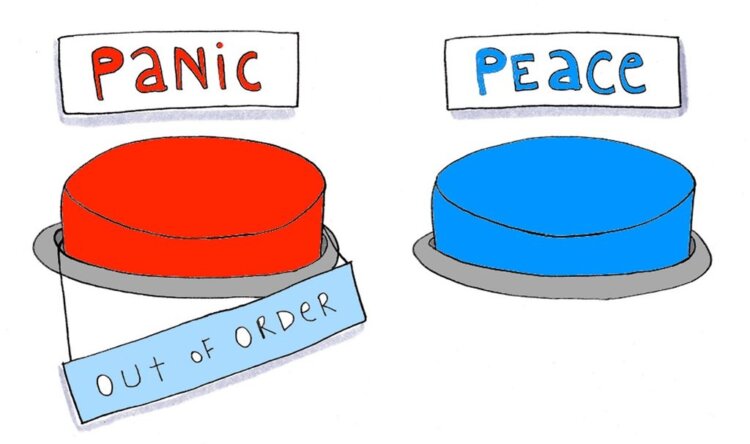
In stressful moments, we often say we’re having a panic attack. But if you’ve ever had a real attack of anxiety, you know you’d do anything for it to be over, as fast as possible. Some of my students have told me about their panic attacks, and I’ve experienced a few of my own, so I wanted to share two effective Yoga-based solutions.
Panic attacks can come on suddenly, without much warning. They can be part of post-traumatic stress, panic disorder, or a mental illness. Most of us will have maybe one or two panic attacks associated with anxiety-provoking situations. Some of us have many more of them, possibly not related to any specific cause. They can make you feel like you’re having a heart attack, or even like you’re dying. They can be terrifying, which only makes the physical symptoms worse.
What is a panic attack, exactly? It’s described as a sudden feeling of acute and debilitating anxiety, often without direct real-time cause. Signs of panic attack include:
- Sweating, shaking
- Nausea, dizziness
- Intense fear (of something specific, or a more general fear of dying or not being in your right mind)
- A feeling that you can’t catch your breath or breathe normally.
That last symptom is one of the most common, and it’s the starting point for ending a panic attack.
As a Yoga instructor, one of the most important things I learned was a breathing practice called Deergha Swasam. It involves all of the lungs, not just the upper chest part of the lobes. (Flashback to Health Ed: Your lungs have two sets of lobes, upper and lower.) Upper lung breathing is the kind we do when the sympathetic nervous system, aka the Fight or Flight Response, is in high gear. Yoga instructors teach Deergha Swasam as a stress reduction technique.
Theoretically, then, if you’re having a panic attack, or just a really stressful moment, you’d want to breathe with the lower as well as upper part of the lungs by using the belly muscles to inhale.
Solution #1: Try Deergha Swasam/Three-Part breathing.
- Find someplace to sit down if you can. Place one hand on your belly and the other on your chest.
- Exhale to a comfortable point.
- Inhale using your belly muscles. Bring that breath to your lower ribs and your upper chest.
- Exhale from your upper chest, lower ribs, and gently pull in your belly.
- Repeat. Focus on the sensations of the breath moving through each part of your body. Repeat a few more rounds until you feel calmer.
Just as one size of Yoga pants does not fit all, one Yoga solution does not fit all problems. Sometimes the shortness of breath associated with panic attacks doesn’t allow for any kind of deep breathing. That’s why I went to Jivana Heyman, founder of Accessible Yoga, for another solution.
Jivana’s Svadharma (his unique path in life) is teaching Yoga instructors how to make Yoga available to every body of every size and health condition. Over years of teaching Accessible Yoga, which includes Yoga for emotional health, Jivana knows that people having panic attacks sometimes can’t catch their breath to do Deergha Swasam.
“It’s true that breathing practices work directly on the nervous system and have such a calming effect,” he says. “But most anxiety attacks create the feeling of not being able to breathe or catch the breath, so extra attention to the breath during an attack can be counterproductive. Instead, I find it’s more helpful to refocus the mind away from the feeling of panic and onto something else with a grounding practice.”
Solution #2: Try a Grounding practice.
- Find someplace to sit if you can.
- Bring your attention to the space around you, feeling your feet against the floor. If possible, take your shoes off so you can really feel the floor with all parts of your feet.
- If you know any Yoga chants, or you have a Mantra, try chanting. Even thinking of an affirmation helps to refocus the mind.
- If it feels possible, try doing some gentle stretches or Yoga poses. A few easy ones: Lie on the floor and put your legs up a wall. Or, gently stretch your head and hands toward your extended legs. Or try a slow and easy walking meditation, where you concentrate on the feel of each step from your toes to your heels.
Other effective tools include petting a dog or cat, talking to a friend, or focusing on an activity, like knitting or drawing. This distracts your mind from the distress that can exacerbate a panic attack.
If you’re prone to panic attacks, a regular Yoga breathing practice can help reduce your level of anxiety when you feel a panic attack coming on. A good practice to try: Alternate nostril breathing. Yogi Cameron, another brother teacher from Integral Yoga (and Madonna’s co-star in her “Express Yourself” video!), guides you through it guides you through it here.
If you have a panic attack, try one of these solutions. If it persists, don’t be afraid or embarrassed to call for help, either from a friend or 911. Don’t let yourself suffer, and don’t think you’re alone. Those of us who have experienced panic are sending you lots of peace.
Suzan Colón is the author of Yoga Mind: Journey Beyond the Physical, 30 Days to Enhance Your Practice and Revolutionize Your Life From the Inside Out.


Grok Nation Comment Policy
We welcome thoughtful, grokky comments—keep your negativity and spam to yourself. Please read our Comment Policy before commenting.